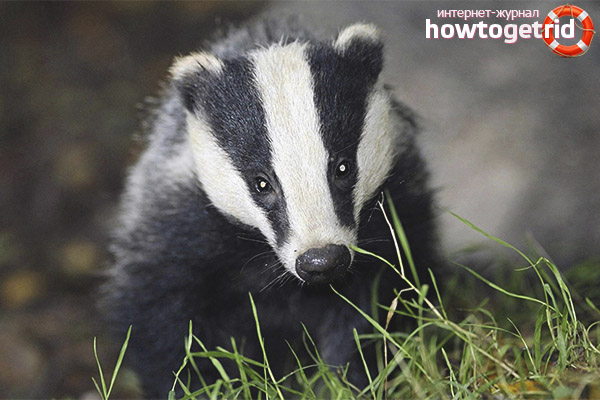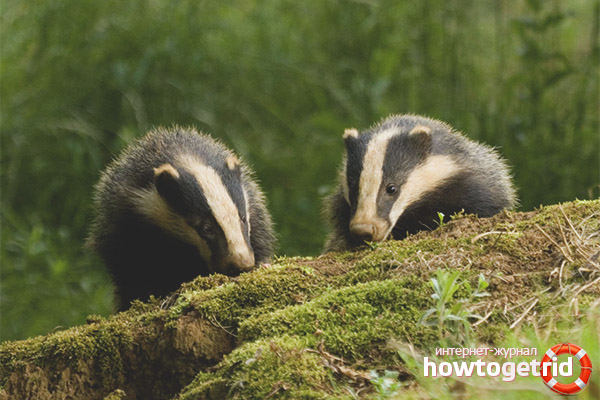The content of the article
The badger belongs to the family of marten, but in many respects differs from its relatives, and in general the beast is quite interesting.
Description
If you describe the body as a whole, then it has a wedge-shaped shape, which reaches the largest size in the back and gradually tapers towards the head. The neck still has a more or less large size and quite thick, but the head is very narrow with small ears.
The tail is approximately equal in length to the head (about 20 centimeters or slightly less). Paws are strong and muscular. The surface of the feet is bare, there are long and strong claws.
Badgers are no more than 80 centimeters in length, and weight changes throughout the year. For example, in spring, a badger weighs about 10 kilograms, and by autumn (when you need to go for wintering) it reaches up to 30 kg.
If you characterize the appearance as a whole, then it is large and squat, and the typical movement to match this appearance. The badger walks quite smoothly and slowly through the forest, almost crawling and snuggling to the ground. Only when there is a danger or you need to solve some problem of fast movement, can he develop high speed and move in leaps and bounds.
On the back and sides of the beast there is a rough and hard fur, which differs from quite rare and short hair on the stomach. The tail is pretty fluffy. It should also be noted the beautiful color of the badger's fur, which consists of a light silver color and black neck, chest and legs.
Every year, the leopard molts, starting in spring and ending this process in late autumn. During the summer, a lower, rarer and coarse fur appears, which acquires a brownish-yellowish hue.
Spread
- European (Central Russian);
- Siberian
- Caspian;
- Amur;
- Kazakhstani.
The most favorable habitats are island forests, which alternate with meadows and fields. Quite rarely, a badger appears in coniferous forests, but it also happens there, although the feed there is much less. There is an opportunity to evaluate the suitability of the badger habitat for the main features.
- Forest, bushes in which a badger can live.
- Conditions for burrowing, optimal conditions are required that allow digging holes.
- The proximity of water, badgers like ponds and running water, which are relevant for everyday life.
The forest provides badgers to everyone. He is a refuge, a source of food and many others.
Biology

As said earlier, the badger is looking for where there are opportunities to create holes. This fact is determined by the mode of existence of this animal; it prefers a semi-underground way of life. The badger chooses the burrow so that there is water nearby and the ability to stealthily approach it.
Regarding which range this beast prefers, there are different opinions, and in reality the issue is not fully understood. It should be reliably said about the main area, which is about half a kilometer from the hole itself, then the badger is rarely chosen. If the territory provides a lot of food, then different families of badgers can live there.
Additionally, the following facts should be said about burrows:
- The badger is rather hardworking and self-sufficient, he does not use the fruits of other people's labor and digs holes for himself, but other animals, in particular foxes and raccoon dogs, use his holes.
- The most preferred spaces for digging holes are the slopes of ravines and river terraces.
- He prefers dry and sandy soil or a mixture of sand, one way or another, he needs a soil that is easy to dig and has a deep occurrence of groundwater.
- Nora is a whole system that includes many moves and exits.
- If the hole is made qualitatively, then more than one generation of the badger family can live there, they have lived there for decades.
- Over the years, the network of moves and the number of “rooms” in a badger’s hole increases, a large and branched hole is called a hillfort.
- A typical burrow exit has an arch shape and is up to ten meters long.
- Somewhere at a depth of a meter underground, there is a nesting chamber, which has a shallow litter of leaves and grass.
- Badger arranges holes for the most part in the fall.
After describing the badger’s home, it’s quite logical to go on to describe his food. He prefers a wide variety of foods and his diet is a combination of animal and vegetable feed. In addition, food is seasonal, that is, more simply, depends on what nature can please for a certain period of the year.
From animal foods it should be noted:
- field mice;
- small birds;
- frogs and other amphibians;
- lizards and other reptiles;
- worms, bugs and other insects.
Plant feeds are for the most part:
- roots and greens of various plants;
- berries and fruits;
- nuts.
In addition, the badger does not disdain to go to farmland. There, for the most part, they are looking for oats and corn.
Basically, a badger is a nocturnal predator. He sleeps during the day, and when dusk sets in, he sets off on his own business. During the day, too, he can get out of the hole, but prefers not to go far from the shelter.
Oriented for the most part thanks to the scent. Vision and hearing are not particularly developed.
In general, a badger should be called a homebody, since for several months in a row it practically does not leave a hole, and in other periods of the year badgers sit a lot in holes, and external movements are connected with holes.
Badger deserves special mention, which has a lot of healing properties. The badger starts to get fat in the fall and gets about 4-5 centimeters of fat and, as mentioned earlier, adds about 20 kilograms in the end. Thanks to its fat, the badger may not leave the hole; by October it lays moves with the ground and falls into a winter dream. The hibernation period depends on the region of habitat. For example, in the south the badger just waits for the cold, and in the north it can lie in the hole from October to May.
In fact, a badger does not hibernate in the strict sense of the word, in simple terms, it just rests in a slight suspended animation. The temperature drops only to 34 degrees and, if there is a thaw on the street, then it may well go for a walk.
Breeding
Having wintered, the animal comes out of the mink and begins to clean its house, to prepare young badgers for the birth. Families of badgers are monogamous, that is, they choose one partner with whom they remain in the family for many years. Mating is not tied to the time of year, unless in the cold season they mate for obvious reasons.
Pregnancy is quite long and the terms can vary from 8 to 15 months, since pregnancy has a latent stage, that is, for some period it can practically stop and then continue again. Young growth always appears in the spring and totals from 2 to 6 individuals. About four weeks, young badgers need to wait until their eyes open and teeth appear.
12 weeks after birth, young badgers begin to crawl out of the mink and gradually settle. It is during this period that they begin to create new pairs.
Badger behavior
Since they mostly move only at dusk, the indicator that allows you to recognize the badger is the sound. They make noise quite actively, unlike many other fans of the dark period of the day, and practically do not hide.
Of the visual signs, the most obvious are the trails that lead from minks for many meters and even hundreds of meters. Such minks do not change over the years and lead to watering, feeding and other significant objects. In addition, badgers leave behind a digging that are associated with the search for food.
On moist soil, traces are quite easy to find, which even an inexperienced person can easily identify. Such footprints are similar to a miniature bear foot. The badger moves rather slowly, therefore it is easy to see it.
The most significant harm and the main impact on the population is people. The human factor is for the most part the destruction of badger fortifications.
It should be noted and especially emphasize the use of badgers for the ecosystem, since it is they who are engaged in the destruction of various carrion, insects and rodents. Therefore, the production of badgers is subject to careful monitoring and uncontrolled activity in this direction leads to a significant deterioration of the forest ecosystem. At the same time, badgers are highly valued for their magnificent fat, which is comparable to bear fat and provides great benefits.
Badger fat has not only high nutritional value, but is also actively used in medicine. In particular, it is used for various heating, joint treatment. The fur of these animals has practically no value.
Video: badger (Meles meles)











Submit